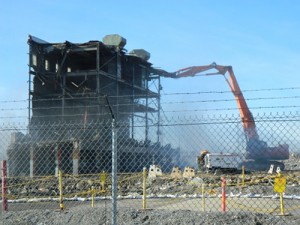It was once the world’s largest building under one roof, built by the U.S. government in less than two years as part of a top-secret race to build the world’s first atomic bombs during World War II.
Officials say it also helped win the Cold War.
But five years after demolition started, the K-25 Building is gone. Officials, workers, and invited guests watched the last section of the giant building crash to the ground on Thursday.
The mile-long, U-shaped K-25 Building enriched uranium through a process called gaseous diffusion. It was the largest facility in the U.S. Department of Energy complex. Debris shipments are expected to be completed in the spring of 2014.
The $1.1 billion project is under budget and ahead of schedule.
Here is more information from a press release:
The K-25 building, located at the East Tennessee Technology Park, formerly known as the Oak Ridge Gaseous Diffusion Plant, was built in 1943 as part of the Manhattan Project. At the time of the Manhattan Project, K-25 was the world’s largest building under one roof. Today, the Department of Energy has successfully completed its largest-ever demolition project.
“Today marks a tremendous accomplishment for the American people – advancing our commitment to the safe and complete cleanup of former Manhattan Project sites,†said Deputy Secretary of Energy Daniel Poneman. “While there is still important clean-up work to do, completing the demolition of the K-25 gaseous diffusion building and doing so ahead of schedule and under budget is a testament to the outstanding Oak Ridge workforce.â€
The K-25 building operated until 1964, producing enriched uranium for defense and commercial purposes. During the past decades, as the facility deteriorated, its demolition was considered among the highest priorities for the environmental cleanup program in Oak Ridge. With the demolition of the K-25 building, only two of the five original gaseous diffusion buildings remain.
The K-25 building demolition project began in December 2008, when Bechtel Jacobs Company LLC, completed demolition of the west wing. URS-CH2M Oak Ridge LLC, or UCOR, took over the project in August 2011 and successfully completed demolition of the building’s east wing and north end.
“I’m proud to have been part of this historic achievement,†said Leo Sain, UCOR President and Project Manager. “This project was a massive undertaking involving many people. We are pleased that UCOR, working hand-in-hand with DOE and the union leadership, was able to safely complete the demolition and bring this project full circle.â€
Although the K-25 building demolition is complete, the historical significance of the facility will live on. In 2012, the DOE, Tennessee State Historic Preservation, Advisory Council on Historic Preservation, City of Oak Ridge, East Tennessee Preservation Alliance, and other consulting parties finalized a plan that lays out a multi-year plan to commemorate the K-25 complex, which contained more than 500 facilities including the K-25 building.
Under the terms of the agreement, the Energy Department will construct a three-story equipment building that recreates a scale representation of the gaseous diffusion technology and contains authentic equipment used in the original facility. The Department’s Office of Environmental Management also agreed to display equipment, artifacts, oral histories, photographs, and videos a K-25 History Center on site. Also, the Department provided a $500,000 grant to preserve the Alexander Inn, a historic structure in Oak Ridge where visiting scientists and dignitaries stayed during their visits to the area.
More information will be added as it becomes available.






Leave a Reply